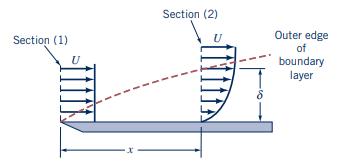Flow of a viscous fluid over a flat plate surface results in the development of a region
Question:
Flow of a viscous fluid over a flat plate surface results in the development of a region of reduced velocity adjacent to the wetted surface as depicted in Fig. P5.25. This region of reduced flow is called a boundary layer. At the leading edge of the plate, the velocity profile may be considered uniformly distributed with a value \(U\). All along the outer edge of the boundary layer, the fluid velocity component parallel to the plate surface is also \(U\). If the \(x\)-direction velocity profile at section (2) is
\[ \frac{u}{U}=\frac{3}{2}\left(\frac{y}{\delta}\right)-\frac{1}{2}\left(\frac{y}{\delta}\right)^{3} \]
develop an expression for the volume flowrate through the edge of the boundary layer from the leading edge to a location downstream at \(x\) where the boundary layer thickness is \(\delta\).
Figure P5.25

Step by Step Answer:

Munson Young And Okiishi's Fundamentals Of Fluid Mechanics
ISBN: 9781119080701
8th Edition
Authors: Philip M. Gerhart, Andrew L. Gerhart, John I. Hochstein





